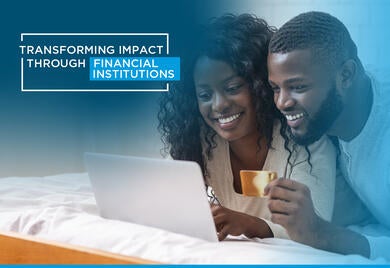
Financial Inclusion, Key to Latin America & the Caribbean's Recovery
Financial inclusion is playing a fundamental role in Latin America & the Caribbean's economic response and will be essential for its economic recovery: such is one of the main conclusions of the Global Microscope 2020 report.

Caribbean Financial Institutions Are Looking to Open their Digital Umbrellas
A shift towards greater digitization was overdue for Caribbean banks, and has been accelerated by the current pandemic. Now, they are rolling out their digital channels, seeking to implement ways in which to help bank customers and employees protect themselves while providing the same and enhanced services.

Does Access to Credit Make People Better or Worse Off?
Traditional credit screening approaches are based on qualifications that many low-income applicants do not have: credit histories, collateral, and verifiable income streams. What if these applicants could be assessed differently?

Blockchain: Democratizing finance
Fourteen million small agricultural producers in Latin America and the Caribbean are exposed to climate change with repercussions on land quality and yield. These producers have very limited ability to access financial services such as agricultural insurance. Less than 20% of local banks serve agribusiness, due to the high costs and the difficulty of assessing credit risk or damages in the case of insurance. The revolution in financial inclusion has the shape of blocks This situation is changing through the introduction of Blockchain in financial services. Blockchain is a technology to carry out financial transactions securely, transparently, and reliably between two separate users, whether banks or individuals, without using an intermediary, so that costs can be reduced. Blockchain technology uses a distributed database that saves blocks of information and links them to facilitate information retrieval and verify that the blocks have not been altered. In the case of agricultural insurance, Blockchain makes possible the use of smart contracts between the farmer and a financial institution, using reliable information based on weather data. One of the advantages is the automatic execution of the contract that relies on predefined conditions without requiring human interpretation. For example, a compensation is paid when a defined quantity of rain is exceeded, causing production losses. Another advantage is that with this model, insurance can be accessible in terms of costs ($2 to $3 per month) and in terms of geographic coverage, which is not feasible with the traditional insurance model. [clickToTweet tweet="Some banks stated that Blockchain-based commercial services will operate before the end of 2017" quote="Some banks stated that Blockchain-based commercial services will operate before the end of 2017." theme="style1"] There are already start-ups developing products that increase financial inclusion using Blockchain technology, such as the Etherisc company with crop insurance. Other applications cover remittances’ transfers, identity and background check systems, clearing and settlement in payment systems, credit history, property registration, and land tenure. The rules of the game are changing for financial institutions With the availability of Blockchain, banks can increase their client base, geographic coverage, and the financial products they offer while reducing operating costs. In an IBM survey, 17% of the banks interviewed stated that Blockchain-based commercial services will begin to operate at commercial scale before the end of 2017. Ignoring this wave of innovation not only means losing an opportunity to contribute to financial inclusion in our region, it also means running the risk of not being competitive and being left out of the market with little notice. Subscribe to receive more content like this! [mc4wp_form]

Banking Agents, On the Frontlines of Financial Inclusion
Banking agents, or small shops contracted by banks to process client transactions, are laying the foundation for the digital transformation of the financial sector. They have also become a safer channel for clients to get cash during the pandemic.

How to attract more private capital to PPPs
As an engine of economic growth and poverty reduction, PPPs are on the rise in Latin America and the Caribbean (LAC). In the last decade, there were approximately 1,000 PPP infrastructure projects valued at $360 billion. Especially, in our current market of constrained fiscal budgets and deep social inequalities, PPPs have become more relevant than ever. Despite this historic uptick, many projects cannot mobilize sufficient private capital. PPPs crowd-in approximately one dollar of commercial finance for every dollar of public finance – a 1:1 ratio which has failed to close the infrastructure funding gap. On the supply side, institutional investors hold funds equivalent to 20 percent of the region’s GDP - a compelling figure when we seek an additional 2-2.5 percent of GDP to meet demand. Managing long-term assets like pensions and insurance is an ideal match for the long-term tenors of PPP projects. In addition, PPPs offer investors relatively predictable repayment schedules, promising financial returns and protection from inflation. In the past, private capital, namely from institutional investors, has been cautious. However the ability to mitigate certain risks is making projects more bankable and piquing investor interest. 1. Legal and regulatory risks Legal and regulatory risks span policies, regulations and institutions. Strengthening them to address market failures, incentivize risk-sharing and regulate consistently reassures investors. Countries are setting up government agencies and units with expertise to supervise PPPs. Advisory services to governments can further strengthen institutions, their regulators and supervisory mechanisms as well as long-term project programming. 2. Project preparation risk Capacity-building combined with the right incentives can mitigate project preparation risk. This can optimize project efficiency, predictability and investor-friendliness. Technical assistance can support project investment plans and share knowledge with public officials at PPP promotion agencies. Supporting investment planning can align PPP development with nationally- determined contributions. This fosters more climate-resilient, sustainable projects. Advisory also allows governments to determine optimal delivery models by conducting value for money assessments to ensure each asset brings value to government agencies, investors and end-users. 3. Foreign exchange risk Most PPPs, except for many in the energy sector, where they are often dollar-denominated, rely on local currency. For a PPP to succeed, avoiding foreign exchange risk is key. Governments are limited in the amount of dollars they can guarantee. Mobilizing local currency allows local borrowers to repay in the currency they are generating cash flow, avoiding mismatches. Currency risk can be mitigated by investors setting up local treasuries to issue debt in local currencies or by providing local currency guarantees project-by-project. 4. Construction risk Construction risk includes expropriation, geological and additional exposures to loss during the construction phase. Investors prefer to invest in PPPs only once construction is complete. However, de-risking projects through liquidity facilities, blended finance, subordinated debt and completion guarantees, which cover construction risk and up to the first 24 months of operation, can bring further comfort and incentivize early entry. Multilateral development banks are uniquely positioned to offer many of the solutions that address legal, regulatory and project preparation risks. IDB Invest (formerly known as Inter-American Investment Corporation), on behalf of the IDB Group, recently mitigated risks and attracted institutional investors in the Reventazón hydropower project in Costa Rica and Campo Palomas and Colonia Arias wind farms in Uruguay. The next phase seeks to bring institutional investors to PPPs and at construction phase. Besides, we can lend in local currency, as we are currently doing in Paraguay, Brazil, Colombia and Mexico, and we can also deploy guarantee and debt instruments to mitigate construction risk. Our in-house experts analyze infrastructure pipelines, support country planning and deploy financial and non-financial products that enhance infrastructure project risk profiles. IDB Invest, on behalf of the IDB Group, recently mitigated risks and attracted institutional investors in the Reventazón hydropower project in Costa Rica and Campo Palomas and Colonia Arias wind farms in Uruguay. The next phase seeks to bring institutional investors to PPPs and at construction phase. As the region’s PPP pipelines continue to grow, we will deploy the solutions to maximize PPP bankability and mobilize more financing. The boost we see in PPPs brings benefits for governments, private firms and the citizens of the countries we serve. [gallery type="slideshow" link="none" size="full" ids="7775,7776,7777"] Subscribe to receive more content like this! [mc4wp_form]